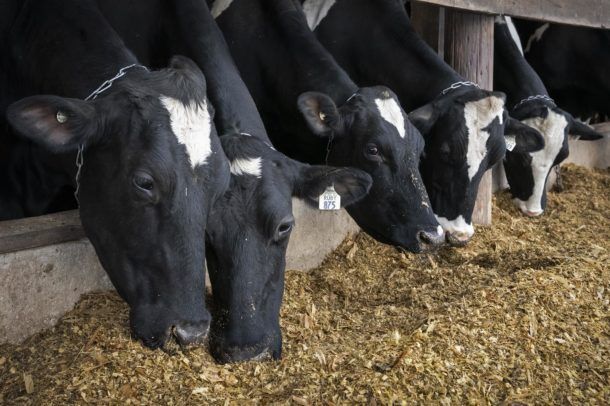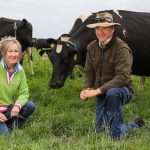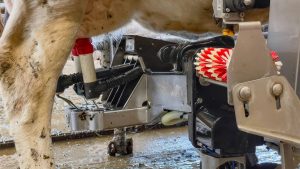
“The feed cost calculation has long been too low, failing to accurately account for the costs incurred by dairy farmers in Vermont and the Northeast in particular,” said U.S. Sen. Patrick Leahy, D-Vt., who chairs the Appropriations Committee, in a press release. “This change will benefit farmers now and in the future at a time when input costs continue to increase at the farm level.
“I applaud Secretary (of Agriculture Tom) Vilsack for working quickly to improve the safety net and provide much-needed relief to producers in Vermont and across the country.”
The Dairy Margin Coverage program is a safety net for small dairy farms, farms that produce less than 5 million pounds of milk per year — generally, farms that have about 200 cows or less. About 73 percent of Vermont dairy farms enroll in the program, and Vermont farms receive an average of $47,500 from the program.
Among them is Liberty Hill Farm in Rochester, where Beth Kennett, her husband and her son milk 112 Holsteins. Kennett said the pandemic has caused milk prices to fall.
“There was a huge drop in milk price last year with all of the schools, restaurants and institutions closed and export closed,” Kennett said. “So the Dairy Margin Coverage program was extremely important.”
Kennett and her family grow their own hay, but machinery, fuel and labor factor into how much it costs to make that hay.
“We have not been able to cover our costs of production for several years,” Kennett said. “The changes to this program will certainly help us work towards covering the rising input costs.”
Because of a change in how cattle feed costs are calculated, Vermont farmers will also be eligible for an additional $3.1 million in retroactive payments for 2020 and 2021.
Leahy, who is also the most senior member of the Agriculture Committee, has been pushing for the changes.
In addition to changing the way it calculates farmers’ costs for cattle feed, the U.S. Department of Agriculture is allowing farmers to get reimbursed for increased milk production since 2014.
Leahy helped establish the Dairy Margin Coverage program in the 2018 Farm Bill. It works like crop insurance, providing free catastrophic coverage to farmers as well as additional coverage farmers pay for, based on their farm’s production history. It allows farmers to insure against rises in feed costs, falls in milk prices, or both.
How it works at the Corse farm
Leon Corse, who raises cows with his daughter on the Corse Farm Dairy in Whitingham, said they paid around $1,200 in premiums for this year’s coverage, the highest they could buy. The insurance paid off more than $20,000 because the difference between the nationally calculated cost of conventional feed and the national price of conventional milk was smaller than what they had insured for.
The Corses insured against the difference between the national price of conventional milk and the national price of conventional feed dropping below $9.50 for every 100 pounds of milk. Because the difference in price dropped below $9.50 most months, they were able to collect insurance.
Because the Corse farm is organic, they are getting a little more for milk than it costs them, but the cost of organic grain and fuel are increasing.
“A farmer is the only business person in society that buys all of his inputs at retail and sells what he has to sell at wholesale,” Corse said.
The Corses have worked their farm since 1868. They ship milk to Organic Valley. They milk about 50 cows and raise all of their 40 or so young cows. They have been rotationally grazing since the 1960s, which means that they move their cows to new grass every 12 hours. Their grass is organic perennial native mix from permanent sod.
“We haven’t had a plow in the ground for 40 years,” said Corse’s daughter, Abbie Corse. “We’re trying to manage for, pardon the pun, whatever organically grows. We’re at 2,000 feet, so nothing grows here well except for cows and grass.”
The USDA has calculated a cost of feed based on a mix of corn, soybean meal and alfalfa hay. Until 2019, the Agriculture Department used the price of conventional alfalfa hay to calculate feed costs. In 2019, it switched to using a mix of the price of conventional alfalfa and premium alfalfa to calculate feed costs. This did not accurately reflect the real cost of feed so, from now on, the cost will be calculated using only the price of premium alfalfa.
“A big shout out to Senator Leahy for getting those changes implemented,” Kennett said. “Those are significant changes.”
Farmers can figure out how much insurance coverage would cost for their dairy operation by using this tool from dairymarkets.org.
Clarification: All dairy farms can buy dairy margin coverage, but the insurance premiums go up after the first 5 million pounds of milk produced each year.























